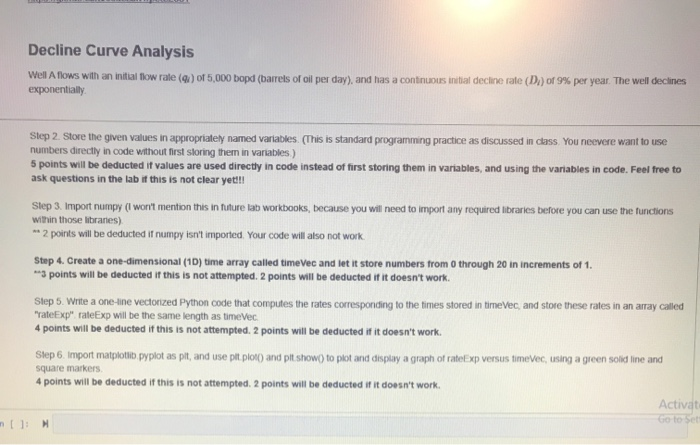Decline Curve Analysis Well Allows with an initial low rate () of 5,000 bopd (barrels of oil per day), and has a continuous initial decline rate (D) of 9% per year. The well declines exponentially Step 2. Store the given values in appropriately named variables. (This is standard programming practice as discussed in class. You neevere want to use numbers directly in code without first storing them in variables ) 5 points will be deducted if values are used directly in code instead of first storing them in variables, and using the variables in code. Feel free to ask questions in the lab if this is not clear yet!!! Step 3. Import numpy (I won't mention this in future lab workbooks, because you will need to import any required libraries before you can use the functions within those libraries) ** 2 points will be deducted if numpy isn't imported. Your code will also not work through 20 in increments of 1. Step 4. Create a one-dimensional (10) time array called time Vec and let it store numbers from - 3 points will be deducted if this is not attempted. 2 points will be deducted if it doesn't work. Step 5. Write a one-line vectorized Python code that computes the rates corresponding to the times stored in timevec, and store these rates in an array called "rateExp" rateExp will be the same length as time Vec. 4 points will be deducted if this is not attempted. 2 points will be deducted if it doesn't work. Step 6. Import matplotib, pyplot as pit, and use pit plot) and it show() to plot and display a graph of rateExp versus timevec, using a green solid line and square markers 4 points will be deducted if this is not attempted. 2 points will be deducted if it doesn't work. Activat 1 Step 7. Print the data type of the time Vec array, using the numpy function "dtype" 2 points will be deducted if this is not attempted or doesn't work. Step 8. Create an array of the same shape with time Vec, call it rateExp2", and initialize it to zeros 3 points will be deducted if this is not attempted. 2 points will be deducted if it doesn't work. Step 9. Instead of the vectorized computation of rateExp. use a for loop to compute the rate, and store this in an array called "rateExp2" 5 points will be deducted if this is not attempted. 2 points will be deducted if it doesn't work Step 10. Plot rateExp2 versus timevec 3 points will be deducted if this is not attempted. 2 points will be deducted if it doesn't work








